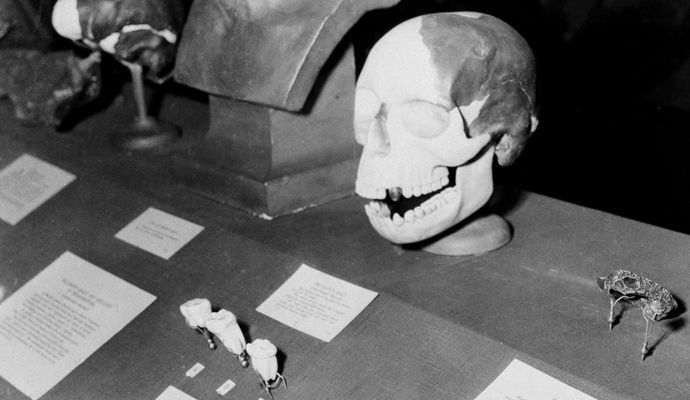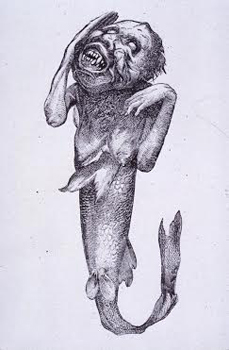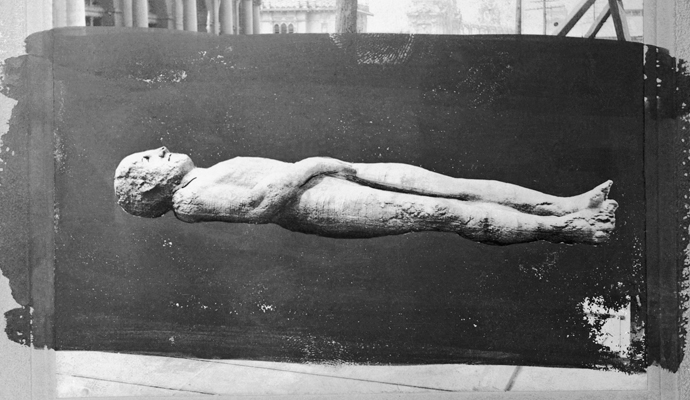The 10 most incredible scientific hoaxes of all time
Mer-monkeys make the list. So does "guitar nipple."


Pranks are generally limited to benign things like dumb Facebook status changes or stunts involving shaving cream. But there are some enterprising individuals that try to get one over on science, with varying degrees of temporary success.
Here's a rundown of some of the biggest scientific frauds in history — at least, the ones that have been exposed:
1) The made-up missing link
The Week
Escape your echo chamber. Get the facts behind the news, plus analysis from multiple perspectives.

Sign up for The Week's Free Newsletters
From our morning news briefing to a weekly Good News Newsletter, get the best of The Week delivered directly to your inbox.
From our morning news briefing to a weekly Good News Newsletter, get the best of The Week delivered directly to your inbox.

1953: Piltdown Man replicas on display at the American Museum of Natural History. | (AP Photo/Tom Fitzsimmons)
The most famous fake of all time is probably the Piltdown Man, a collection of jaw and skull fragments discovered in the U.K. between 1911 and 1912, purportedly pieces of a "missing link" between humans and apes. But as archaeologists found more and more early human fossils in Africa, and none in England, the facts didn't seem to add up.
In 1953, the Piltdown Man was officially declared a fraud by Time magazine, which collated numerous lines of evidence. Fluorine tests on the Piltdown Man's teeth (fluorine accumulates in bones and teeth over time) showed that the fossils were less than 50,000 years old, much too early for such an ape-like missing link. Someone had filed down the Piltdown Man's teeth to make them look more human, and artificially stained the fossils to make them look older than they were. The Piltdown Man was actually constructed from the skull of a medieval human, the lower jaw of an orangutan, and fossil chimpanzee teeth.
It's still unclear just who perpetrated the Piltdown Man hoax. The prime suspects include Charles Dawson, the amateur archaeologist who dug up the fragments, or one of his team members. Others have implicated an unusual suspect: "Sherlock Holmes" creator Arthur Conan Doyle, who lived near the excavation site at Piltdown and had the anatomical knowledge that could be put to work in creating a fake missing link.
A free daily email with the biggest news stories of the day – and the best features from TheWeek.com
2) The little (and very ugly) mermaid

Fake fossils and artifacts are probably the most common type of scientific hoax, and before the Piltdown Man, the world was treated to the Fiji mermaid. In 1842, English gentleman Dr. J. Griffin presented the New York City press with the body of a "mermaid" supposedly caught in the South Pacific. Dr. Griffin gave lectures to packed crowds on his theories of natural history, arguing that there were seagoing counterparts to all land creatures — and as there are lions and sea lions, surely there had to be merpeople to go along with regular people.
The press and the public ate it up. But "Dr. Griffin" was actually Levi Lyman, an accomplice of circus showman P.T. Barnum, who drummed up a host of publicity with the hoax. And the "mermaid" was actually an ape sewn to a fish, an art piece thought to have been crafted by a Japanese fisherman.
3) The petrified giant

(Bettmann/CORBIS)
P.T. Barnum plays a small supporting role in another famous hoax pulled in the 19th century: the Cardiff giant. But the star of this particular scheme was George Hull, a tobacco dealer from Binghamton, New York. Hull had supposedly overheard evangelical preachers talking about giants in the earth, and happened to be acquainted with a gypsum quarry that produced a stone with blue streaks that looked remarkably like human veins.
Hull secretly had a Chicago stonecutter carve a statue from a giant slab of gypsum, finely crafted down to the fingernails and skin pores. The "giant" was buried on Hull's cousin's farm and left there for half a year. When some fossils were dug up on a nearby farm, Hull directed his cousin to hire laborers to dig a well; in the course of their work, they found the 10-foot-tall "petrified man."
Crowds thronged to see the Cardiff giant, and Hull sold the majority of interest in his fraud to a syndicate headed by a banker named David Hannum. Barnum sought to buy the giant, but was rebuffed; the enterprising showman then simply hired sculptors to make a copy. In newspaper accounts of the two giants, reporters quoted Hannum uttering a famous phrase eventually attributed to Barnum: "there's a sucker born every minute."
4) A bird-brained fraud

(AP Photo/O.Louis Mazzatenta, National Geographic Society)
Surely we enlightened modern folk must be harder to fool, right? Hardly.
In the realm of recent fossil fakes we have "Archaeoraptor," a supposed missing link between birds and dinosaurs unearthed in China in the 1990s. Though it was never authenticated in a scientific paper, "Archaeoraptor" got splashy treatment in a 1999 issue of National Geographic. But scientists soon discovered that Archaeoraptor was actually cobbled together from the tail and hind legs of the small dinosaur Microraptor zhaoianus, while the head and rest of the body came from an ancient bird called Yanornis martini.
It's thought that a Chinese farmer glued several fossils into a whole specimen to try and get more money for the find. At the time of the fraud, the connection between birds and dinosaurs was still somewhat new to the public, so Archaeoraptor's exposure as a fraud threatened to cast unfair suspicion on the rest of the scientific evidence for feathered dinosaurs.
5) The day gravity throws in the towel

(Thinkstock)
Some gullible Twitter users expected that on April 4 of this year, a planetary alignment would negate Earth's gravity in such a way that they'd be able to float about. But this "Zero G Day" got a big fat zero on accuracy.
As astronomer Phil Plait pointed out well in advance, the planets weren't even going to remotely line up on April 4.
Plus, "even if they were perfectly aligned, the planets' combined gravity is only about 2 percent of the Moon's," Plait groused in his debunking of Zero-G Day over at Slate. "It's not like the Moon can fling you around the room uncontrollably when it's up in the sky."
Though the other planets in our solar system are quite massive, the huge distance between them and us negates any effects they might have. Though it's 318 times more massive than Earth, Jupiter is 410 million miles away. When you run the numbers, as NASA did, you'll find that the Earth's downward pull on you is 34 million times stronger than any upward tug from Jupiter.
The original Zero-G Day rumor has its roots in an April Fool's Day prank by the late Patrick Moore, a British astronomer who hosted BBC radio and television shows for decades. On April 1, 1976, Moore told listeners that a conjunction of Jupiter and Pluto would perturb gravity on Earth — if they jumped into the air at exactly 9:47 that morning, they should feel a floating sensation.
Though the Zero-G Day prank was as false in the 1970s as it is today, the BBC nonetheless received a host of calls from people who claimed to have floated around the house.
6) Mary Toft, bunny mama

In 1726, the English gossip mill was churning over the curious case of Mary Toft, a 25-year-old woman who had supposedly given birth to nine dead baby rabbits (as well as other things, including parts of a dead cat and a hog's bladder). Mary became something of a celebrity, and delivered subsequent litters of rabbits.
But some medical experts were skeptical. German surgeon Cyriacus Ahlers examined one of Mary's rabbits, and found dung pellets with traces of corn, straw, and hay — things that probably were not available inside Mary Toft's womb. The fraud was fully exposed after a servant was caught trying to sneak a rabbit into Toft's room. Soon after, Toft confessed that she inserted rabbits into herself by hand.
7) The robot that mated Ben Franklin

One of the first popular robots was the Mechanical Turk, a chess-playing machine built by 18th-century inventor Wolfgang von Kempelen. A mannequin attired in Turkish robes and turban sat behind a large cabinet, which had a chessboard atop it. The machine debuted in 1770 at the court of Empress Maria Theresa of Austria, and the Turk defeated courtier after courtier with its swift, aggressive style of play, even besting Benjamin Franklin and Napoleon Bonaparte.
However, the Turk wasn't actually an automaton. Even at the time, people offered theories: the Turk's small cabinet concealed a child, or perhaps a dwarf, or a chess-playing monkey, or a double leg amputee. But the cabinet was actually cleverly constructed to allow a full-sized adult to fit inside, and to use magnets and strings to control the Turk's moves.
8) Secrets of an alien autopsy

In 1995, Fox aired a special hosted by Star Trek: The Next Generation actor Jonathan Frakes called Alien Autopsy: Fact or Fiction? The show featured footage of an "alien dissection" supposedly taken right after the famed UFO crash outside Roswell, New Mexico.
But the footage, provided by a British producer named Ray Santilli, was ridiculously obvious as a hoax — the alien body appeared rubbery, the camera became unfocused when it got near the body, and the autopsy appeared to be astoundingly rushed for one that would have been such an awesome discovery for science.
In 2006, Santilli admitted to journalists that the footage was faked — but only because his actual alien autopsy footage wasn't good enough for broadcast, he said.
9) Blondes: hunted to extinction?

(Thinkstock)
In 2002, many news organizations issued worried reports about a new endangered species: blonde-haired humans. Supposedly, a study funded by the World Health Organization predicted that the gene for natural blonde hair would be weeded out of the human race by 2202.
One slight problem: the WHO was surprised as anyone to hear about the story, since it had never conducted research on the subject.
"WHO has no knowledge of how these news reports originated but would like to stress that we have no opinion on the future existence of blondes," the organization said.
False studies aside, the premise that blond hair is doomed to disappear off the face of the Earth isn't that likely.
"Genes don't die out unless there is a disadvantage of having that gene or by chance," University of Edinburgh dermatologist Jonathan Rees told the BBC at the time. "They don't disappear."
Plus, there's no single gene for light-colored hair in humans — in fact, it's thought to have evolved more than once (besides blond-haired Europeans, there's also a big crop of blondes in the Solomon Islands due to a specific change in a single protein). So, if some catastrophic extinction of blondes did occur, there's no reason that the trait couldn't evolve again.
10) Suffering for their art

(Christopher Polk/2013 Getty Images for Clear Channel)
In 1974, the British Medical Journal published a short letter from a John Murphy, who was responding to an earlier article where a Dr. Curtis reported three cases of "guitar nipple" — a slight inflamed swelling in the breasts of young girls training on classical guitar.
"Though I have not come across 'guitar nipple' as reported by Dr. P. Curtis… I did once come across a case of 'cello scrotum' caused by irritation from the body of the cello," Dr. Murphy wrote. "The patient in question was a professional musician and played in rehearsal, practice, or concert for several hours each day."
It wasn't until 2009 that John Murphy (not a doctor, but chairman of St. Peter's Brewery) and his wife, Dr. Elaine Murphy (the physician who actually wrote the letter, and a current member of the U.K.'s House of Lords) came clean in the pages of the journal: they made up the whole thing. They said they wrote the spoof partly because they believed the guitar nipple case report was also a hoax.
"Anyone who has ever watched a cello being played would realize the physical impossibility of our claim," the Murphy's wrote in their decidedly non-apologetic mea culpa.
More from World Science Festival...
-
 7 bars with comforting cocktails and great hospitality
7 bars with comforting cocktails and great hospitalitythe week recommends Winter is a fine time for going out and drinking up
-
 7 recipes that meet you wherever you are during winter
7 recipes that meet you wherever you are during winterthe week recommends Low-key January and decadent holiday eating are all accounted for
-
 Nine best TV shows of the year
Nine best TV shows of the yearThe Week Recommends From Adolescence to Amandaland